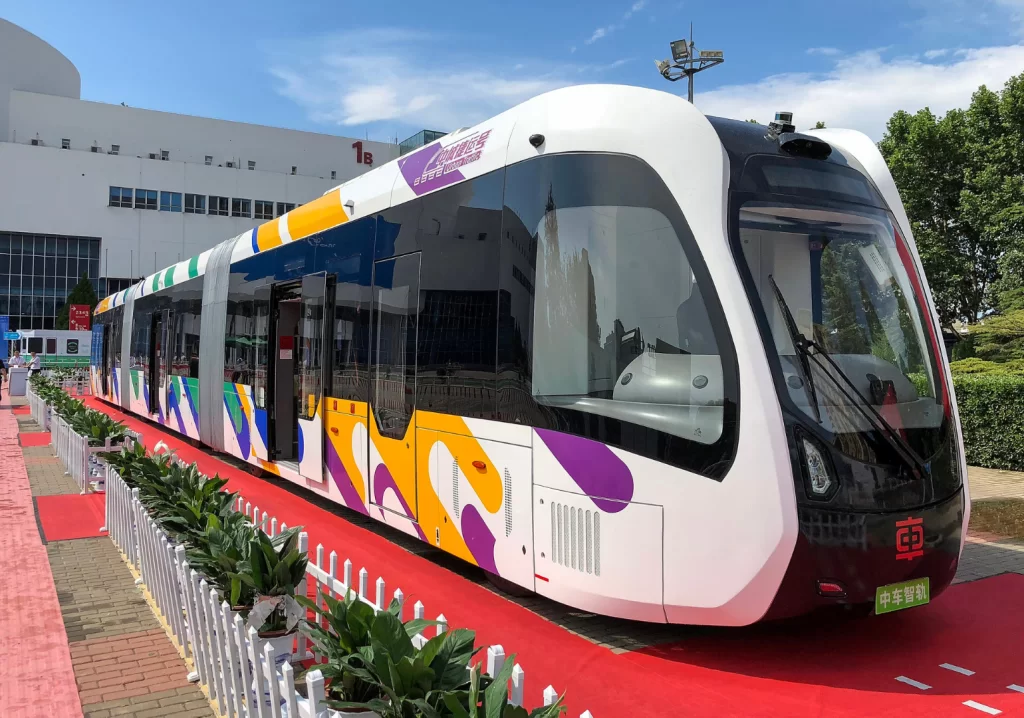Touted as a lower-cost option than light rail, trackless trams need to attract intensified development around station locations for the systems to justify capital costs.
The idea of mid-tier transit is to link a city’s activity centres together, plus all the points in between.
Trackless trams offer an alternative mid-tier transport option to more established technologies such as bus rapid transit (BRT) and light rail transit (LRT), incorporating facets of high-speed rail into an autonomous, tram-like battery-operated vehicle.

Last year, the City of Stirling in Perth initiated the nation’s first trackless tram trial via a 30 m-long zero-emissions vehicle that travels 70 km/h, with urban centres such as Brisbane and Melbourne also considering this technology.
“Cities looking at trackless trams are trying to get the benefits of light rail without the big price tag,” Steven Piotrowski FIEAust, Technical Principal – Transport Modelling at SMEC, told create.
Piotrowski will be participating in the Trackless Trams: Effective and Practical implementation panel at the upcoming Transport Engineering Conference, organised by the Transport Australia Society with the support of Engineers Australia.
But the interaction between land use and transport has a significant role to play in effective implementation, with high-density developments around any mid-tier transit station required.
“People think about building systems to solve transport problems,” Piotrowski said. “But they’re also really important in terms of the land use around the system, and what could happen in the future if the system is built.”
Trackless trams are a low-cost option
LRT is the most expensive form of mid-tier transport, with a large proportion of the costs associated with laying the tracks, and the significant utility expenditures that are often required.
“Replacing and relocating underground pipes and wires is often done at the same time, which has a tendency to blow out the costs of these systems,” Piotrowski added.
As rubber-tired vehicles that run on concrete, trackless tram systems don’t necessarily require existing roads to be torn up. But there are still infrastructure upgrade considerations.
The batteries that sit atop the trackless trams cause heavy axel loads. Furthermore, because they are optically guided, trackless trams tend to run in the same exact location time and time again, leading to focused loading on the pavement.
“The normal thickness of pavement is insufficient for trackless trams because they are quite heavy vehicles,” he said. “Significant pavement strengthening will be required to accommodate trackless trams because the concentrated loads on the pavement are going to be greater than they would be in normal traffic.”
Will they attract density?
The distinctions between different modes of mid-tier transit are becoming increasingly blurred, with BRT, trackless trams and LRT beginning to look more alike.
But according to the Australian Transport Assessment and Planning (ATAP) Guidelines, a transport system’s ability to attract density is highly dependent on the perceived permanence of the station infrastructure. Other important considerations include the frequency of service, the provision of a dedicated right of way – which considerably improves the reliability of the service – and the amenity of the street environment.
“If you’re building a system and you want it to be successful and reliable, the number one consideration is to provide a dedicated right of way,” Piotrowski said. “That means not mixing with general traffic to ensure the trams are not delayed by traffic congestion.”
Attracting the public to choose the transport system over cars is also an important piece of the puzzle.
“Frequency and reliability are the two most important things that people look at when they’re considering whether they’re going to use public transport,” Piotrowski said. “It has to be a safe system, but more people will use it if there’s good information and waiting facilities.”
But crucially, mid-tier transport systems have to be seen as permanent to provide the private sector with confidence to enable investment in adjacent and nearby sites.
“One common criticism of BRT is that it may be there today but could be gone tomorrow,” he said. “So you need good quality station facilities that are permanent to signal that the transport system is here to stay.”
Each of these mid-tier transit technologies should theoretically be able to attract the same amount of density around stations.
“But in reality, there’s a perception that rail-based systems are able to attract more density.”
Supporting land use policies that encourage density to occur in the locations where mid-tier transit will be implemented is essential.
“You need to work on both the transport and the land use side in order to get a successful transit-oriented development,” Piotrowski said.
“It all has to be carefully planned, designed and implemented. Depending on how that’s done, it will send the right signals to the private sector.”
The Transport Engineering Conference is on until Friday in Melbourne.
The upcoming Climate Smart Engineering Conference 2024 (CSE24) brings together some of the profession’s best thought leaders to navigate the clean energy transition.
